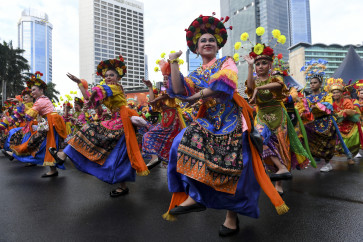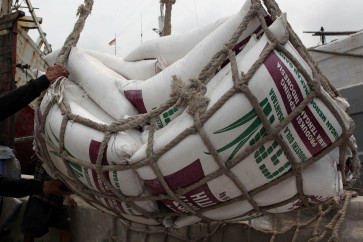Popular Reads
Top Results
Can't find what you're looking for?
View all search resultsPopular Reads
Top Results
Can't find what you're looking for?
View all search resultsThe real great leap forward: Lessons from history
The Communist Party of China (CPC) initially collaborated with the Nationalist Party under Chiang Kai-shek in the long struggle against the invading Japan’s Imperial Army
Change text size
Gift Premium Articles
to Anyone
T
he Communist Party of China (CPC) initially collaborated with the Nationalist Party under Chiang Kai-shek in the long struggle against the invading Japan’s Imperial Army.
After defeating the Japanese and driving the Nationalist Party to its escape on Taiwan Island, Mao
Zedong proclaimed the establishment of the People’s Republic of China on Oct. 1, 1949, and ushered the people of China into a completely new era.
Since the crises leading to the collapse of the Qing Dynasty in 1912, the last of China’s monarchy, China had suffered long years of chaos and turbulence caused by civil war, the yoke of Western powers, and Japanese invasion.
Mao Zedong undertook some significant reforms like introducing legal protection of women’s right and the abolition of polygamy as well as slavery, and no less important: land reform for the 90 percent of the population who were farmers. Next, 1951-1952 was the so called “Three Anti Five Anti” movement directed against enemies of the state found mostly in corrupt members of the CPC and big capitalists in private businesses.
After failing to implement the Soviet model for the first Five-Year-Plan from 1953 to 1957, Mao Zedong declared the launch of the Great Leap Forward at a CPC meeting in Nanjing in January 1958.
The move was aimed at building a modern communist society by pursuing agriculturization, industrialization and collectivization as targets of the second Five-Year-Plan intended to run from 1958 to 1963. However, the great leap ended in a great economic and particularly humanitarian disaster claiming some 20 to 30 million lives by
some estimates due to famine in the rural areas.
The failure of the Great Leap Forward entailed profound consequences, not only in economic terms, but also in political shifts. Mao Zedong resigned as state chairman in 1959, leaving the economic recovery to Liu Shaoqi as the new state chairman and Deng Xiaoping as the CPC secretary-general. Nevertheless, Mao had been apprehensive about the pragmatic economic directions adopted by Liu and Deng since the 1960s, and had prepared steps for a comeback.
Mao Zedong commenced a fight back campaign against the two functionaries and other known pragmatists by launching the The Great Proletarian Cultural Revolution, also known as The Cultural Revolution on May 16, 1966, and intensively carried out until 1968.
The Cultural Revolution became sad history not only for China, but also for the world, as many historical, cultural and literary heritages fell victim to a massive pogrom and persecution. It only came to an end officially in 1976 with the demise of Mao Zedong.
By 1973, Deng Xiaoping had made his political resurfacing and in 1975 he secured strategic positions as a member of the decisive Politburo Standing Committee, People’s Liberation Army’s chief of staff, and executive vice-premier, effectively taking charge in place of the then ailing Premier Zhou Enlai. So when Mao Zedong passed away in 1976, Deng Xiaoping or “Deng the Little Peace” was ready to lead China further into an era of reconstruction.
In December 1978, Deng Xiaoping declared The Four Modernizations at a plenum of the Central Committee, which was originally a strategy designed by Zhou Enlai in 1963. By then he was 74 years old, which was probably the reason TIME magazine published an article in January 1979 titled “Little Man in a Big Hurry”.
There is no doubt that The Four Modernizations have made way for “The Real Great Leap Forward”. This step was taken in concert also with an adjusted foreign policy, this time with real efforts to open the country up to the big power game, particularly with the United States. When president Nixon and secretary of state Kissinger visited Beijing in 1972, it was more in the interest of the US to play the “Chinese Card” against the menacing Soviet power under Leonid Brezhnev. Yet when Deng Xiaoping visited the US in 1979, he played the “Chinese Card” in the sole interest of China.
He did not make it to witness the transfer of sovereignty of Hong Kong on July 1, 1997, as he passed away on Feb. 19 of that year. Nonetheless, there is no doubt that Deng Xiaoping left a monumental legacy in historical terms, as mentioned by journalist Jim Rohwer: “the Dengist reforms of 1979-1994 brought about probably the biggest single improvement in human welfare anywhere at any time.”
Further leadership under “The Third Generation” ushered in by president Jiang Zemin and premier Zhu Rongji had the benefit of making The Four Modernizations into a “Real Great Leap Forward”. As a result, by August 2010 China had taken over Japan’s position as the second-largest economy in the world, which enables it to flex its military force.
“The Fourth Generation” of leaders under President Hu Jintao and Premier Wen Jiabao has become confronted by increasing social unrest as a result of the development and economic gap between the coastal and hinterland regions. Yet it is very likely that China has found its own suitable path in history.
How should Indonesia fare with a strong and now richer northern neighbor? If we may draw lessons from history, it is always dilemmatic to have a neighbor. The best thing would be if you were wealthy and strong on your own terms. If that is not the case, we should prefer to have a rich neighbor rather than a poor one, particularly if it is a large and populous country. Because poverty and its consequential anger used to spill over exactly like wealth and its resulting complacency do. Don’t forget the difficult years of the 1960s when China was under the helm of Mao Zedong. Nevertheless, if your neighboring country is powerful, then make sure that first you are on good terms with it, and second convince it that any attack against you would end up as merely an expensive Pyrrhic victory.










